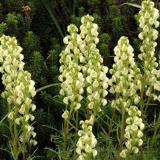 © Pete Saloutos/Panoramic Images (Washington Title Image Large)
© Pete Saloutos/Panoramic Images (Washington Title Image Large)

West Cascades Vegetation
The wet and relatively mild conditions in the West Cascades support magnificent conifer forests. Forests of Douglas-fir and western hemlock predominate on the lower slopes, with western red cedar growing in moist sites.
In lowland areas of Mount Rainier National Park, patches of old growth rainforest still support trees up to a 1,000 years old. These ancient Douglas-firs offer habitat for dozens of additional plant and fungal species.
At mid-elevations Douglas-fir and western hemlock are joined by Pacific silver fir and noble fir. Lush wildflower meadows occur in these subalpine areas.
The highest reaches of the West Cascades are characterized by stands of mountain hemlock and subalpine fir. At timberline, these trees can form low-lying, gnarled stands of krummholz. In areas prone to avalanches, stands of flexible Sitka alder can thrive.
Up to elevations of roughly 11,000 feet, the volcanoes in the West Cascades host alpine meadows and heath fields. Some of these heath fields have been around for some 10,000 years. Mount Rainier is home to 30% of the species in Washington’s native flora.
A number of broad leaf trees line the ecoregion’s river valleys. Among them are black cottonwood, bigleaf maple, red alder, and Oregon ash.
For details of this ecoregion within Washington, click a subheading in the left column.
View the more general description of this ecoregion in North America
Krummholz: German for "twisted wood," this term applies to low-growing trees near timberline; their growth is shaped by harsh and windy conditions . >back



